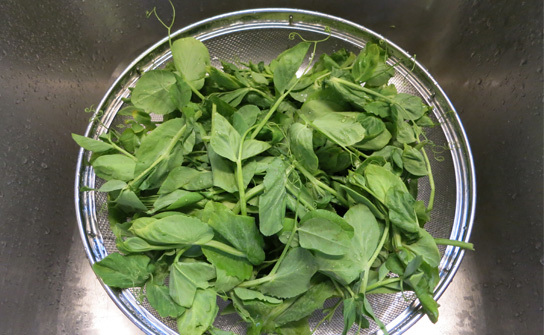 June-19-2023
June-19-2023
View: 3

Pea shoots are an excellent source of micronutrients that are often lacking in many people's meals.
Pea tips, also known as snow pea tips, are a delicious and nutritious addition to any culinary repertoire. These tender leaves and stems are harvested from mature snow pea plants and are widely used in East Asian cuisines, particularly Chinese cooking. If you come across a small leafy bundle on a relatively thick stem that has been clipped off a larger plant, chances are you've found pea tips.
When it comes to growing pea tips, it's important to note that snow peas are cool-season crops. They thrive when temperatures are below 80 degrees Fahrenheit, making them an excellent choice for planting in autumn. By sowing the seeds in late autumn, you can expect a bountiful mid-spring crop around late October and November.
To get started, prepare a well-draining garden bed or container with nutrient-rich soil. Snow peas prefer a location with full sun exposure, so choose a spot that receives at least six hours of direct sunlight per day. Before planting, ensure that the soil is loose and has been amended with organic matter to promote healthy growth.
When it comes to planting snow peas, sow the seeds about an inch deep and two to three inches apart. Allow for sufficient spacing between rows, typically around two feet, to provide the plants with ample room to grow. Water the seeds gently but thoroughly, ensuring that the soil remains consistently moist throughout the growing season.
As the snow pea plants emerge and begin to grow, it's important to provide them with proper support. Snow peas are climbing plants that require trellises, stakes, or a support structure to help them grow vertically. This not only saves space but also prevents the delicate pea tips from touching the ground, which can lead to disease and pest issues.
Once the snow pea plants start flowering, it's an exciting indication that the pea tips will soon be ready for harvest. Generally, snow peas can be harvested about 10 weeks after sowing the seeds or approximately 10 days after flowering. Pick the pea tips when the pods are young, tender, and flat. These are the prime moments when the flavor is at its peak, offering a crisp and refreshing taste.
To use snow pea tips in your culinary endeavors, there are numerous possibilities. One popular method is to stir-fry them, which allows the vibrant green color and delicate flavor to shine. Heat a wok or skillet with a small amount of oil over high heat, and toss in the pea tips along with your choice of seasonings and spices. Stir-fry for a few minutes until the pea tips have wilted slightly but still maintain their crispness. This method ensures a quick and flavorful dish that can be enjoyed on its own or as a side dish to complement various main courses.
Pea tips can also be used in salads or added to soups and stews for a nutrient boost. Their tender texture makes them suitable for raw consumption, and they provide an excellent source of protein, fiber, as well as essential vitamins and minerals such as vitamin C, A, and K.
Growing and using pea tips (or snow peas) can be a rewarding experience for any home gardener or cooking enthusiast. With proper care and attention to their cool-season preferences, you can enjoy a vibrant and flavorful harvest of tender pea tips. Whether you choose to stir-fry them, add them to salads, or incorporate them into your favorite dishes, pea tips are a versatile and nutritious addition to elevate your culinary creations.
#Peatips #Snowpeas #Robbenfoods